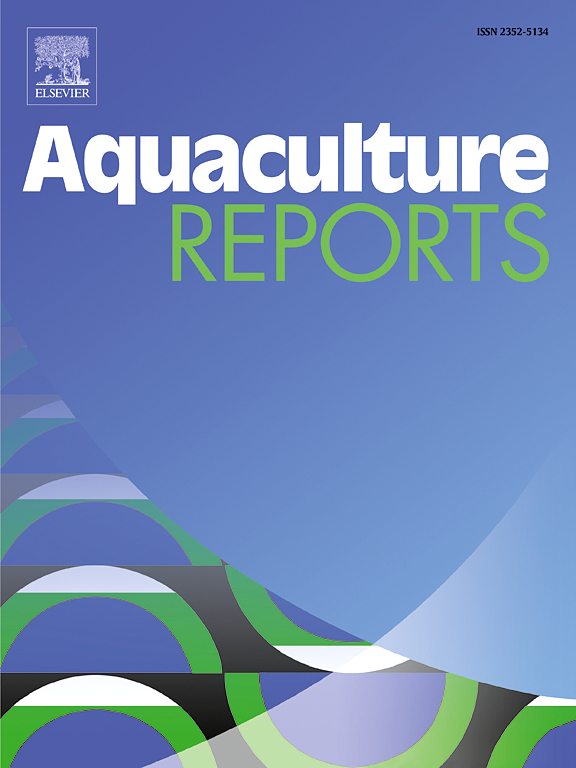WSSV和氨氮胁迫对万年青酶活性和转录组的影响
IF 3.2
2区 农林科学
Q1 FISHERIES
引用次数: 0
摘要
白斑综合征病毒(WSSV)是水产养殖业中的一种重要病原体,对对虾养殖业构成严重威胁。本研究选择南美白对虾作为研究对象,以确定引发 WSSV 爆发的氨氮临界浓度。采用多组学技术,从生理、生化和转录组学角度研究了凡纳滨对虾在氨氮胁迫条件下由WSSV感染状态转变为急性感染状态的综合反应机制。通过LC50试验测定了氨氮和WSSV对凡纳滨鲤的毒性,并得出了72 hpi、96 hpi、120 hpi和144 hpi的半致死浓度。H&E染色显示了WSSV感染、氨氮胁迫以及氨氮和WSSV联合胁迫诱导的凡纳滨鲤肠道病理变化。对 DEGs 的 KEGG 通路富集分析表明,PI3K-Akt-mTOR 信号通路的激活会引发细胞的代谢重编程,这有利于 WSSV 诱导的沃伯格效应和增殖。阻断 PI3K-Akt 信号通路可减少 WSSV 感染细胞的凋亡,从而抑制病毒复制。值得注意的是,氨氮胁迫破坏了对虾与 WSSV 潜伏感染之间的平衡,增加了对 WSSV 感染的易感性,并加重了感染的严重程度。氨代谢受阻导致氨氮水平升高,加重宿主的炎症反应和氧化应激,引起细胞内氧化损伤和宿主组织损伤,削弱宿主的免疫功能,不能有效抵抗 WSSV 感染,导致 WSSV 复制加速和疾病爆发。本文章由计算机程序翻译,如有差异,请以英文原文为准。
Effects of WSSV and ammonia nitrogen stress on the enzyme activity and transcriptome of Litopenaeus vannamei
White spot syndrome virus (WSSV) is an important pathogen in the aquaculture industry that poses a serious threat to the shrimp farming industry. In this study, Litopenaeus vannamei was selected as the research object to determine the critical concentration of ammonia nitrogen that triggered the outbreak of WSSV. Multiomics techniques were used to study the comprehensive reaction mechanism of L. vannamei, which is in a state of WSSV infection and transforms into acute infection under conditions of ammonia nitrogen stress, from physiological, biochemical, and transcriptomic perspectives. The toxicity of ammonia nitrogen and WSSV to L. vannamei was measured by the LC50 test, and semilethal concentrations at 72 hpi, 96 hpi, 120 hpi, and 144 hpi were obtained. H&E staining revealed pathological changes in the intestinal tract induced by WSSV infection, ammonia nitrogen stress, and combined ammonia nitrogen and WSSV stress in L. vannamei. KEGG pathway enrichment analysis of the DEGs revealed that activation of the PI3K-Akt-mTOR signaling pathway triggers metabolic reprogramming of cells, which is conducive to the WSSV-induced Warburg effect and proliferation. Blocking the PI3K-Akt signaling pathway could reduce the apoptosis of WSSV-infected cells, thereby inhibiting viral replication. Notably, ammonia nitrogen stress disrupted the balance between shrimp and WSSV latent infection, increased the susceptibility to WSSV infection, and aggravated the severity of infection. The obstruction of ammonia metabolism leads to an increase in ammonia nitrogen levels, aggravates the inflammatory response and oxidative stress of the host, causes intracellular oxidative damage and host tissue damage, weakens the immune function of the host, and cannot effectively resist WSSV infection, leading to the acceleration of WSSV replication and disease outbreaks.
求助全文
通过发布文献求助,成功后即可免费获取论文全文。
去求助
来源期刊

Aquaculture Reports
Agricultural and Biological Sciences-Animal Science and Zoology
CiteScore
5.90
自引率
8.10%
发文量
469
审稿时长
77 days
期刊介绍:
Aquaculture Reports will publish original research papers and reviews documenting outstanding science with a regional context and focus, answering the need for high quality information on novel species, systems and regions in emerging areas of aquaculture research and development, such as integrated multi-trophic aquaculture, urban aquaculture, ornamental, unfed aquaculture, offshore aquaculture and others. Papers having industry research as priority and encompassing product development research or current industry practice are encouraged.
 求助内容:
求助内容: 应助结果提醒方式:
应助结果提醒方式:


